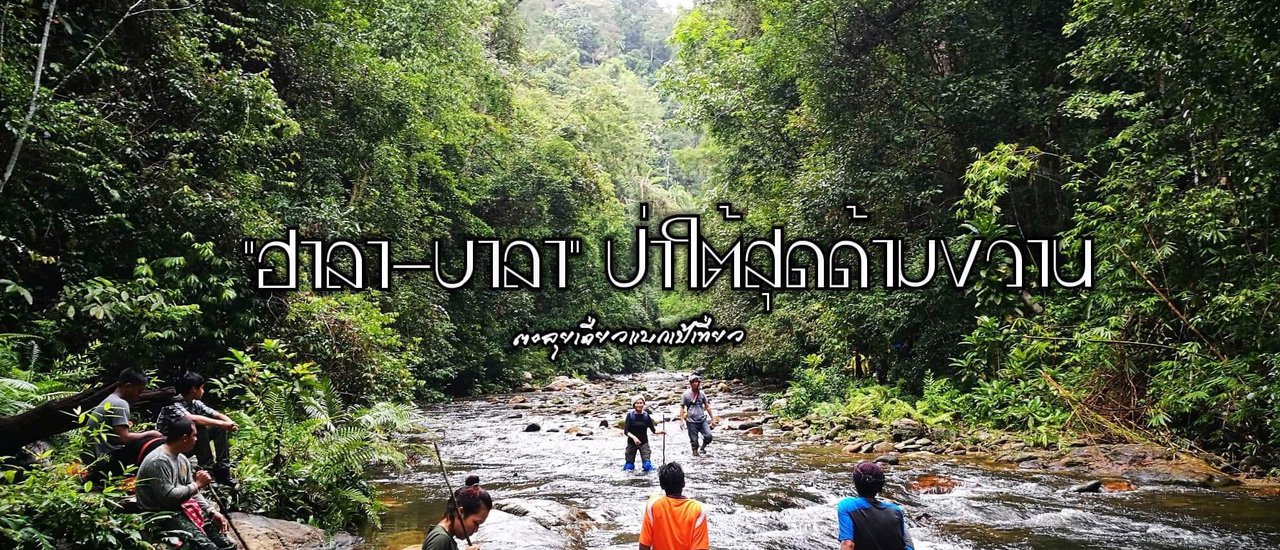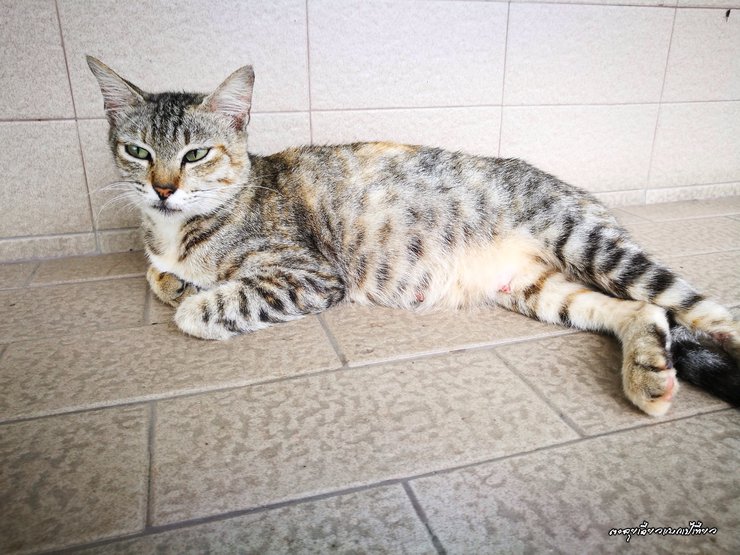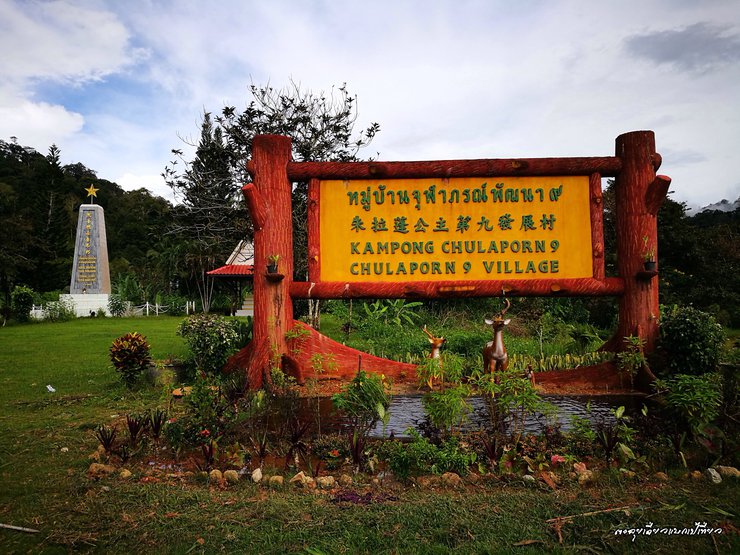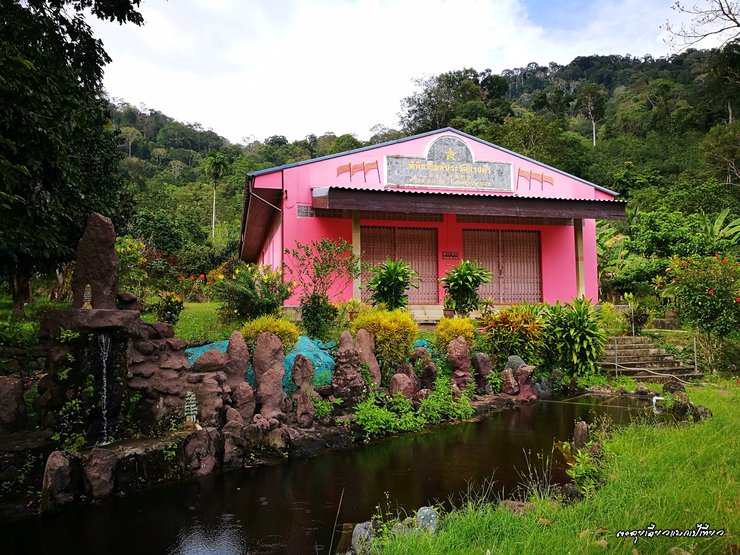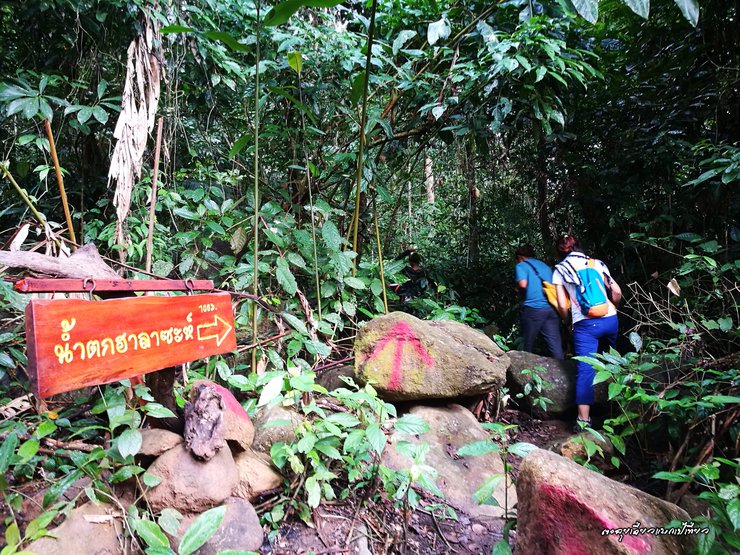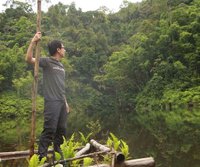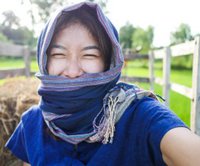This trip was initiated by a suggestion from a fellow traveler on the Mae Hong Son trip. It was a new route opening trip for the Ban Chulabhorn Phatthana 9, Thanto, Yala community tourism.
We embarked on a journey to meet the gang in Hat Yai. We traveled in a rented van with a skilled driver who was very familiar with the route. Along the way, we made a stop at a gas station to play with some cats.

The van stopped at the first viewpoint, Bang Lang Dam. I had wanted to visit Bang Lang since my previous trip to Betong. During that trip, the water level was low because the dam was undergoing spillway maintenance.

The van took a winding road up and down the mountain for 30 minutes before arriving at Chulabhorn Development Village 9. Located on the edge of the Halabala Forest, the village is home to a tourism group, homestays, and a local museum that tells the story of the communist groups that once lived in the forest. As soon as we arrived, we set off to explore the village.


The accommodation will be in a large building divided into 6 rooms with ensuite bathrooms. There is also a communal area with a TV and a kitchen for cooking. The bathrooms have flush toilets and gas water heaters. The ladies can choose their rooms first, leaving 2 rooms for the men. This trip has 3 men and 7 women.


The time has come for the tour group to set their program. The first point is to go to Halasah Waterfall, which is about 1 kilometer from the village. It is a concrete road, sometimes good, sometimes bad, depending on the condition. Then walk into the forest for about 100 meters.

The trail is lush with greenery, featuring an abundance of towering trees, flourishing mushrooms, and a variety of moisture-loving plants.

We arrived at Halaszah Waterfall. The water level was low during our visit, making it easier to climb to the top.

The upper part has less water, with greenery and a cool breeze.


The provided text is empty. Please provide the text you want me to translate.
After visiting Halaszha Waterfall, we went to a pond to catch Chinese fish for dinner. The fish are raised in a flowing water pond and are still caught by hand. The girls prepared the food while we climbed the langsat trees, picking and eating the sweet, juicy fruits. There were many trees, and everyone said we could eat from any of them.

It took over an hour to cook the meal. As novice cooks, we only managed to grill fish. This was our first time sharing dinner with the community, the family who raised the fish, and the village's tourism group. We were impressed. We usually eat freshwater fish, but here they are raised in flowing water and fed rice, which eliminates any fishy odor. It was a truly heartwarming meal.

After dinner, there was a discussion about the next day's hike, including restrictions and precautions. The tour group was determined to make our experience enjoyable and memorable. Back at the guesthouse, we exchanged travel stories with our fellow travelers, who included guides, community tourism workers, public relations professionals, university professors, and professional photographers. The exchange made us realize how limited our travels had been, and we were eager to explore more.
On the second morning of our trip, we woke up early to breathe in the fresh air. As we stepped out of the cabin, we were greeted by a blanket of mist, which added to the excitement of the day.


We encountered two local dogs who eagerly led us on an adventurous path towards Halaszah Waterfall.



Breakfast was a delicious rice porridge. After we were full, we prepared to hike. Today, we used the trail of Chulabhorn Development Village 7. As soon as we got off the car, we each received a lunch set.

The trailhead for the Chulabhorn 7 village development forest walk is located at the village itself. The hike begins at 9:00 AM and starts with a section that crosses a stream and enters the forest. The trail features gradual ascents and descents, leading to the first destination: the Chulabhorn 7 waterfall, which shares its name with the village. The walk to the waterfall takes approximately 40 minutes.



After relaxing and soaking in the cool water, one group decided to return to Chulabhorn Development Village 9, where they would learn about herbal medicine and acupressure. We chose to continue on the path, which involved steep ascents and descents. At some points, we had to climb over rocks and fallen trees. The rain made the path slippery, and at times we had to slide down the slopes rather than walk. Leeches were out in force, attaching themselves to our bodies. As we walked, we began to hear the screams of the girls, who were not fond of the leeches. The path had to be cleared as we went.

Halfway through the walk, we stopped for lunch on a hilltop with enough flat space for everyone to relax comfortably.

After we were full, we continued walking, and the path became more challenging. It started raining, making the experience even more exciting. Hiking in the jungle is not suitable for brightly colored plastic raincoats, as they easily get snagged and torn, not to mention being very hot and causing you to lose even more body water.


After a two-hour hike, we finally reached the waterfall. It was an unnamed waterfall, and everyone enjoyed swimming in its refreshing waters.

The time for adventure is over, it's time to head back before nightfall. This trip wasn't planned for sleeping in the wild, and the return journey involved wading through the same chilly water as the arrival.

On the way back, there was more time to enjoy the scenery, and I saw more things.

He arrived at the parking lot at exactly 6 pm.

For dinner tonight, I was delighted with the stir-fried parkia speciosa. I was the only one who ate it.

The third morning of the trip began with a mesmerizing display of rolling mist.



Today's hike covered approximately 18 kilometers, starting at 8:00 AM from the Bang Lang National Park Ranger Station (Halasah Waterfall). The hike was led by park rangers, and we were joined by local youth who are the next generation of tourism leaders. The trail was a mix of easy and challenging sections, with some uphill climbs, downhill slopes, and sections following natural waterways. While not as technically difficult as yesterday's hike, it was significantly longer. Along the way, we encountered leeches, insects, giant ants (whose bites were quite painful), and an abundance of large trees that left us in awe.



The area boasts a rich diversity of flora, including flowers, trees, mosses, ferns, and various types of mushrooms.





After reaching the peak today, they stood in groups to chat.

Today's hiking destination was the crystal-clear stream in the heart of the Halabala forest. However, the journey was not without its challenges, as our bodies were repeatedly pierced by the thorns of the nipa palm trees, sending us tumbling into the thickets with each encounter.

We continued our journey through the dense ferns, making it difficult to walk. Our guide had disappeared, walking ahead of us at a brisk pace. The group behind us was still far behind. We decided to walk along the riverbank instead, hoping it would be faster and allow us to catch up with the guide. We did catch up with him, and he was crossing the river, cutting back and forth to find the easiest path. At this point, when the water level is high, the entire area is flooded, making it impossible to see the tree stumps and trees.


As the trail became more challenging, we slowed our pace and split into two groups. Our side had to climb over trees and boulders, while the other side had an easier path but a longer distance. The side we chose reached the designated meeting point first and waited for the other team to arrive. After a long wait, the other team arrived and was about to cross the river. However, there was an incident. The crossing point was muddy and slippery, and the driver got stuck in the mud. Two people from the other team went to help pull him out. The situation was met with much laughter and amusement.

After everyone had crossed, the Border Patrol Police (BPP) stationed in the area informed them that it would be impossible to exit the forest before nightfall. Two options were presented: 1) Spend the night at the BPP unit, or 2) Take a boat along the Nam Sai Canal to the rubber plantation in Chulabhorn Development Village 7. The guide and team leader decided to contact a boat for pick-up. As they waited, darkness gradually enveloped the surroundings. The first boat arrived after a 20-minute journey from the pick-up point, making for a nerve-wracking experience in the pitch-black darkness, especially for those who couldn't swim. It took approximately one hour for everyone to arrive, including the time spent waiting and walking from the riverbank to the road in complete darkness. Flashlights and手机闪光灯 provided minimal assistance. The day's trek covered only 12.12 kilometers in 9.22 hours, with the remaining distance covered by boat and car.

As we journeyed back to our lodgings, the rain lashed down relentlessly, leaving us shivering with cold. Upon our arrival, a wave of relief washed over those who had anxiously awaited our return. The evening meal was another delightful and memorable experience, filled with lively conversation and bursts of laughter that echoed louder than ever before.

The sentence is already in English and does not require translation.
On the fourth morning of the trip, we met at 4:30 am to go to the Pha Hin Yok rock formation to watch the sunrise and the sea of mist covering the Halabala forest. Arriving at the trailhead near Chulabhorn 7 village, we started hiking uphill. The trail was steep and slippery from the previous night's rain. By the time we reached the top, the dew was so heavy that we were soaked from head to toe. We were about to give up, as the weather conditions were not conducive to seeing the sun and the sea of mist. Everything was just too foggy.


After a period of anticipation, the wait for beauty has been rewarded. The skies have cleared, revealing a breathtaking sea of mist above the lush green forest.



After returning, I went to the rocking stone cliff. This is how the cliff got its name.
After returning to the accommodation to prepare for departure, the tour group took us to visit the community's historical museum.



Leaving the community, I stopped to take another picture of the Bang Lang Dam.

After leaving Bang Lang Dam, we stopped to sample street food all the way to Hat Yai. In the late evening, we climbed Khao Kho Hong to enjoy the view of the city lights of Hat Yai.


This trip concluded with an abundance of positive impressions, including the exploration of the pristine rainforest of Halabala, the opportunity to learn and reside with a diverse religious community that coexists harmoniously, the enjoyment of local cuisine prepared with fresh ingredients, and the formation of friendships with individuals from various backgrounds.
If you are interested in experiencing the beauty of this place, you can contact the Chulabhorn 9 Development Village Tourism Community page for more information: https://www.facebook.com/Chulaborn9/
Follow other travel trips at
Page: Solo backpacking travel
IG: prapat / 0roamholic0

The sentence is already in English and does not require translation.
ตะลุยเดี่ยวแบกเป้เที่ยว
Wednesday, October 9, 2024 5:58 PM

